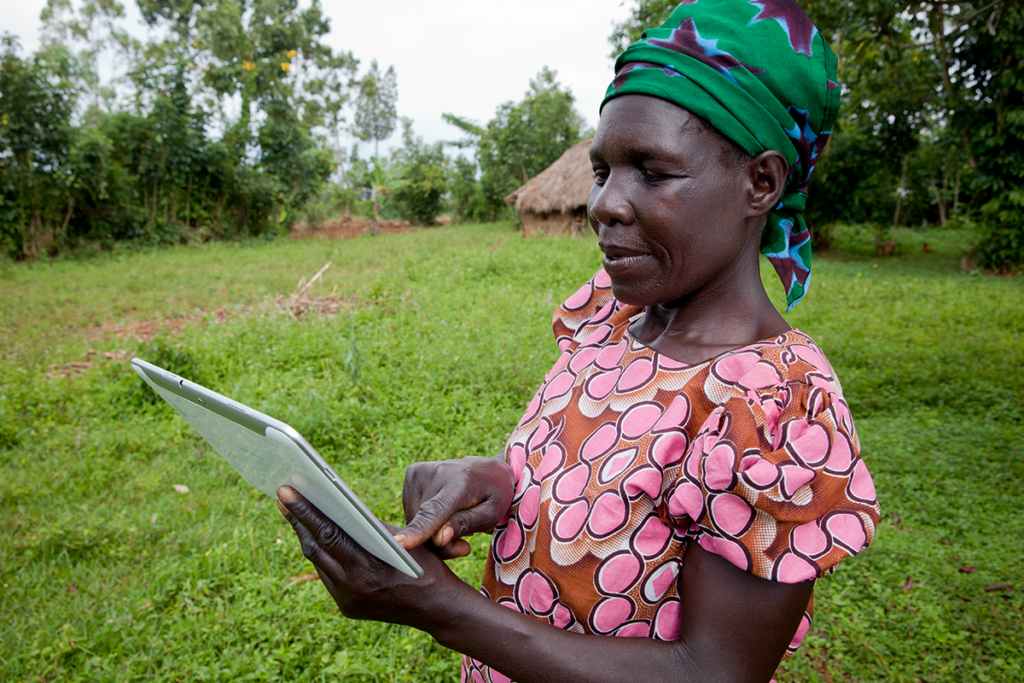Research conducted by Ericsson and the Earth Institute on the role of information and communication technology (ICT) in achieving the Sustainable Development Goals concludes that “every goal — from ending poverty and halting climate change to fighting injustice and inequality — can be positively impacted by ICT” (Ericsson, 2015). Projects utilizing ICT for climate change adaptation in developing countries indicate great potential for new technologies, such as mobile phones, and traditional technologies, such as radio broadcasts, to improve data gathering and dissemination of information on adaptation options (Ospina and Heeks, 2010). What is lacking, however, is evidence of the impact of combining multiple technologies with an institutional framework supporting the generation and dissemination of climate and agricultural information. An assessment of the use of multiple ICT — such as mobile phones, FM radio and community loudspeakers — combined with institutional arrangements to support ICT deployment is needed to better tailor the design of ICT interventions for climate change adaptation in developing countries.
In this post, we present the research design for an ongoing study of the Climate Change Adaptation and ICT (CHAI) project in Uganda. Our study investigates how the current approach of CHAI with its multiple ICT tools, institutional arrangements and local-to-national actors contributes to program impact. We intend for the findings of our study to inform the design of information and communication technologies for development (ICT4D) programs in the future.
Background
In Uganda, higher average temperatures and more frequent and severe climatic incidents like droughts and floods result in diminished food security, a decrease in the quantity and quality of water, and deteriorating natural resources, negatively affecting health, settlements, and infrastructure (UNDP-UNEP 2009). Figure 1 demonstrates that Uganda is getting warmer, especially in the last two decades. Temperatures were on average lower in the early twentieth century but have steadily and gradually increased since. This is a critical issue for agriculture.

Figure 1: Temperature trends in Uganda, 1930–2009 (Degrees Celsius); Source: Shinyekwa, et al. 2017, using data from EM-DAT: The OFDA/CRED International Disaster Database, 2015
The destructive impact of droughts and floods continues to be felt by the Ugandan people and the national economy. Preliminary analysis conducted by the United Nations International Strategy for Disaster Reduction in 2011 using Uganda’s national disaster loss database shows that over 50 percent and 18 percent of the Ugandan population are affected by drought and floods, respectively (UNDP-UNEP 2009). The 2011/12 annual performance report of the Government of Uganda cites drought as one of the main reasons for achieving only 3.2 percent of GDP growth against a projected growth of 7 percent for the reporting period.
In January 2012, FHI 360 and Uganda partners launched the pilot CHAI project with funding from the International Development Research Centre, Canada (IDRC). The project fosters community adaptation to climate change-induced challenges by developing and testing the effectiveness of an ICT-based system for the collection, reporting, analysis, and dissemination of information on water-related climate hazards, risks, and adaptation mechanisms.
Study aims and objectives
To support desirable impacts, ICTs cannot function in isolation; they should be combined with institutional arrangements that facilitate and support the use of the ICT-based tools and actors who champion the use of technology for maximizing impact. Hanna and Summer (2015) note that successful ICT-enabled development is dependent on the interplay of five interdependent elements: 1) enabling policies and institutions that “are critical in promoting the supply and use of ICT services in all sectors”, 2) a skilled workforce, 3) a dynamic ICT ecosystem capable of adapting technology to local needs and managing technology platforms, 4) an affordable communication infrastructure, and 5) “ICT applications and complementary investments in institutional changes to transform key economic sectors”. However, there is only a weak understanding of the factors that facilitate ICT-enabled development in developing countries. Our study aims to close this gap.
Our research team is examining the case of the CHAI project in Uganda to understand how the project’s approach, which combines the use of multiple communication channels (specifically, mobile phones, interactive radio and face-to-face meetings), an institutional framework to support the generation and dissemination of information, and actors who act on received information, contributes to program impact.
The primary question is: How does an approach that combines the use of multiple ICT tools, institutional arrangements, and actors contribute to program impact?
We hypothesize that farmers with enhanced access to location-specific (sub-county level) climate and agricultural information are more likely to make better informed farming decisions based on received information, which will subsequently lead to the reduction of crop loss and damage, and improve crop production and increase income.
As the research question is broad, we operationalize the study with the following sub-questions:
- Was access to information improved?
- Was the information effective for farmers?
- What were the changes in institutional arrangements?
In answering the above sub-questions, the study will show how:

Methodology
The study uses structured household surveys, focus group discussions and semi-structured in-depth interviews. We use comparisons of baseline conditions and changes observed in midline and endline outcomes between the treatment and comparison districts to understand impacts of the treatment (i.e., the CHAI approach) in minimizing crop loss and damage.
The analysis primarily makes a comparison between the treatment districts as one unit (Nakasongola, Soroti and Ssembabule districts) and a comparison unit (Rakai district). Where different surveys have been conducted on the same sample, we compare the same variables across the different surveys. In this respect, answering sub-questions one and two largely relies on measuring the performance between treatment districts and the comparison district across the surveys.
We will conduct balance tests using analysis of variance (ANOVA) to verify that the treatment and comparison groups are balanced with respect to exposure to climatic risks and ability to cope with risks. The test will reveal if the groups differ significantly in terms of exposure to drought, unpredictable rainfall pattern, gender, age, farm size, education/literacy level, occupation (main source of livelihood), and access to technology (mobile phone, radio and TV). If the treatment and comparison groups are not balanced with respect to these variables, we plan to do matching based on those known variables.
We are also collecting qualitative secondary data through focus group discussions with farmers for information on:
- the major climate-related hazards faced by farmers
- how the hazards affected assets, farms and livelihood
- information received to minimize risks related to the hazards and its effectiveness
- crop loss and damage sustained by the farmers due to the climate-related hazards
- to what extent farmers acted on information received and impediments faced to transform acquired information into action
For the qualitative analysis, we will transcribe, code and analyze the recordings of focus group discussions. We will concentrate in particular on identifying sub-themes under the three research questions.
Q1: Was access to information improved?
The analysis will gauge the levels of access to and adoption of agricultural information between the treatment and comparison groups. In this way, the analysis of ease and ready availability of information will indicate the treatment’s impact on access. The analysis will further examine 1) the frequency of dissemination of weather-related information to households in the treatment and comparison districts, 2) the sources of such information to households, and 3) the reliability of the channels used.
Key variables to note from baseline, midline and endline surveys: access to climate/agricultural information; access to communication channels; farmer preference for communication channels; type of information received.
Q2: Was the information effective for farmers?
The surveys ask households how they use the information they receive to avert and mitigate weather-related and climate change hazards. The analysis of these data will establish whether the information generated and disseminated by CHAI is relevant to farmer needs. By observing the actions adopted by farmers when faced with climate-related hazards, we can assess the relevance of the information they received. In particular, we will analyze the difference in adaptation strategies between treatment and comparison districts and also estimate the rates of adoption of recommended strategies within the treatment districts. The analysis will establish if the crop damage or loss is significantly different between the treatment and comparison groups and over the different time periods. We will estimate a difference of means among the treatment and comparison districts over time.
Key variables to note from midline and endline surveys: actions taken based on received information; crop loss and damage.
Q3: What were the changes in institutional arrangements?
For this analysis, we will use social network analysis (SNA). In social network analysis, a network is composed of actors, represented as a vertex or node in the graph, and edges or links that connect the actors or nodes. We will use key informant interviews to collect data on the following relationships between different actors at national, district, sub-county and village levels in the treatment and comparison districts:
- formal lines of command
- informal linkages
- climate and agricultural information sharing
- provision of support and advice to farmers
- provision of resources to farmers (such as inputs, loans, etc.)
We will also analyze the institutional arrangements employed for the generation and dissemination of information to farmers and that support farmers in applying the information they receive into action. Our study team will assess the changes in institutional arrangements facilitated by the project and the importance of such changes in improving access, relevance and effectiveness of information disseminated to farmers.
We anticipate that our findings will help understand the factors that facilitate ICT-enabled development in developing countries. Our research continues through August 2018 and we plan to have a completed manuscript shortly thereafter.
We will share our findings in future posts!
Photo credit: Jessica Scranton/FHI 360



